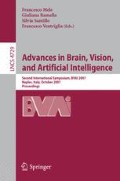Abstract
In this paper we analyze the influence of the frequency of sensor data readings on the behaviours of a Robotic System (RS). This is done in the framework of behaviour based architectures drawing inspiration from biological and ethological evidences. In the first part of this paper we recall some notions on biological clocks, showing how to represent those clocks in terms of Schema Theory. Then, we propose an architecture in which the frequency of access to the sensory system is modified in accordance with environmental changes. We evaluate the results obtained in experiments with simple behaviour based systems in unknown environments with obstacles. In the last part of the paper, we briefly discuss the possibility of extending the proposed model to more complex robotic systems and to teams of robots.
Access this chapter
Tax calculation will be finalised at checkout
Purchases are for personal use only
Preview
Unable to display preview. Download preview PDF.
References
Aschoff, J.: Circadian Clocks. North Holland Press, Amsterdam (1965)
Ishida, N., Kaneko, M., Allada, R.: Biological clocks. In: First Japanese American Foundation of Science Symposium, Irvine, CA (August 1998)
Hastings, M.: The brain, circadian rhythms, and clock genes. BMJ 317, 1704–1707 (1998)
Brooks, R.S.: A robust layered control system for a mobile robot. In: Readings in uncertain reasoning, pp. 204–213. Morgan Kaufmann Publishers Inc., San Francisco, CA, USA (1990)
Arkin, R.C.: Behaviour Based Robotics. MIT Press, Cambridge, Massachusetts (1991)
Arbib, M.A.: Schema theory. In: The handbook of brain theory and neural networks, pp. 830–834. MIT Press, Cambridge, MA, USA (1998)
Piaget, J.: Biology and knowledge. University of Chicago Press, Chicago (1971)
Craik, K.: The Nature of Explanation. Cambridge University Press, Cambridge (1943)
Tinbergen, N.: The study of instinct. Oxford University press, Oxford (1951)
Koukkari, W.L., Sothern, R.B.: Introducing Biological Rhythms. Springer, Heidelberg (2006)
Mirolli, M., Parisi, D.: Artificial organisms that sleep. In: Banzhaf, W., Ziegler, J., Christaller, T., Dittrich, P., Kim, J.T. (eds.) ECAL 2003. LNCS (LNAI), vol. 2801, pp. 377–386. Springer, Heidelberg (2003)
Biological Rhythm. In: Columbia Electronic Encyclopedia (2007)
Benjamin, D.P., Lonsdale, D., Lyons, D.: Integrating perception, language and problem solving in a cognitive agent for a mobile robot. In: Proceedings of the Third International Joint Conference on Autonomous Agents and Multiagent Systems, pp. 1310–1311. IEEE Computer Society, Washington, DC, USA (2004)
Nehmzow, U.: Scientific Methods in Mobile Robotics - Quantitative Analysis of Agent Behaviour. Springer, Heidelberg (2006)
Benjamin, D.P., Lyons, D., Lonsdale, D.: Adapt: A cognitive architecture for robotics. In: International Conference on Cognitive Modeling, Pittsburgh, PA (July 2004)
Carpenter, G.A., Grossberg, S.: A neural theory of circadian rhythms: Ashoff’s rule in diurnal and nocturnal mammals. Am. J. Physiol. Regul. Integr. Comp. Physiol. 247, 1067–1082 (1984)
Burattini, E., Datteri, E., Tamburrini, G.: Neuro-symbolic programs for robots. In: The proceedings of NeSy’05 Neural-Symbolic Learning and Reasoning, Workshop at IJCAI-05, Edinburgh, Scotland (August 2005)
Blank, D.S., Kumar, D., Meeden, L., Yanco, H.: The pyro toolkit for ai and robotics. AI Magazine 27(1) (2006)
Author information
Authors and Affiliations
Editor information
Rights and permissions
Copyright information
© 2007 Springer-Verlag Berlin Heidelberg
About this paper
Cite this paper
Burattini, E., Rossi, S. (2007). A Robotic Architecture with Innate Releasing Mechanism. In: Mele, F., Ramella, G., Santillo, S., Ventriglia, F. (eds) Advances in Brain, Vision, and Artificial Intelligence. BVAI 2007. Lecture Notes in Computer Science, vol 4729. Springer, Berlin, Heidelberg. https://doi.org/10.1007/978-3-540-75555-5_55
Download citation
DOI: https://doi.org/10.1007/978-3-540-75555-5_55
Publisher Name: Springer, Berlin, Heidelberg
Print ISBN: 978-3-540-75554-8
Online ISBN: 978-3-540-75555-5
eBook Packages: Computer ScienceComputer Science (R0)

